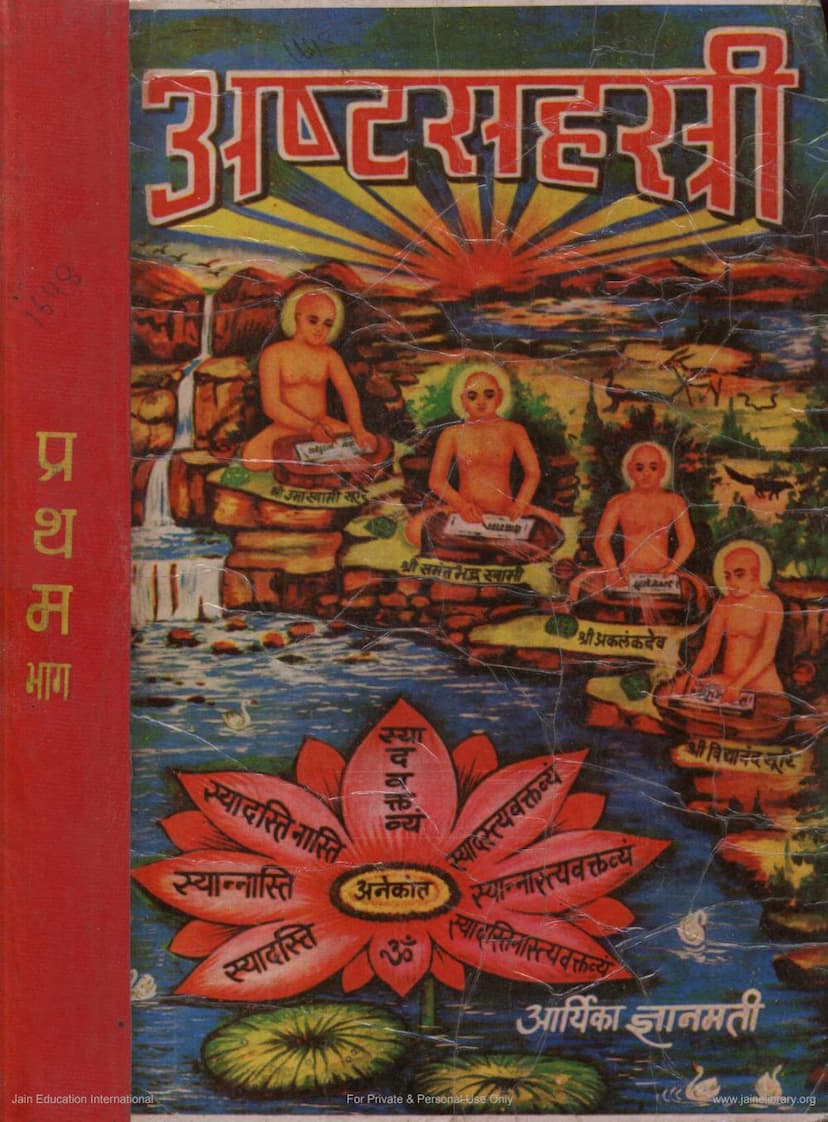Ashtsahastri Part 1
Added to library: September 1, 2025

Summary
Here's a comprehensive summary of the provided Jain text, Ashtasahastri Part 1, based on the index and introductory pages:
Ashtasahastri Part 1: A Comprehensive Summary
Book Title: Ashtasahastri (First Part) Author(s): Vidyanandacharya, with a commentary by Gyanmati Mataji Publisher: Digambar Jain Trilok Shodh Sansthan, Hastinapur Language: Sanskrit (original text), Hindi (commentary)
Overview: Ashtasahastri, meaning "a thousand explanations," is a profound commentary on the Aptamimamsa (also known as Devagam) by Acharya Samantabhadra. Aptamimamsa itself is a commentary on the Aptapariksha of Acharya Umaswami, which deals with the validity of testimony and the nature of the liberated soul (Arhat). Ashtasahastri, composed by the eminent Jain logician Acharya Vidyanandacharya, is considered a monumental work in Jain philosophy, renowned for its rigorous dialectical arguments and comprehensive refutation of various philosophical viewpoints. The provided text is the first part, containing the initial six karikas (verses) of the original work, along with a detailed Hindi commentary titled "Syadvadachintamani" by Aryaika Gyarmati Mataji.
Publisher and Commentary: The Digambar Jain Trilok Shodh Sansthan, Hastinapur, is the publisher, dedicated to promoting Jain scriptures and research. Aryaika Gyanmati Mataji, a highly revered Jain scholar and spiritual leader, is the commentator. Her commentary, "Syadvadachintamani," aims to make the complex philosophical concepts of Ashtasahastri accessible to a wider audience. The text includes introductory blessings and appreciations from prominent Jain Acharyas, highlighting the significance of this work and the translator's efforts.
Key Philosophical Concepts and Structure:
The Ashtasahastri, through its commentary on Aptamimamsa, delves into core Jain philosophical principles, particularly focusing on Syadvada (the doctrine of conditioned predication) and Anekanta (non-absolutism). The book systematically refutes various non-Jain philosophical schools by presenting their arguments (purvapaksha) and then demolishing them with Jain logic.
The first part of Ashtasahastri, as presented in this index, covers the initial discussions and refutations of various doctrines. The index outlines the following key sections:
- Mangalacharan (Invocation): The text begins with auspicious invocations and salutations to the Tirthankaras, Jain lineage of Acharyas (Umaswami, Samantabhadra, Akalankadeva, Vidyanandacharya), and the Goddess Saraswati, setting a spiritual and intellectual tone.
- Guru Vandana (Salutation to Gurus): It pays homage to the spiritual lineage of Acharyas, starting from Acharya Shantisagarji Maharaj, through his disciples Acharya Virsagarji Maharaj, and then to the commentator Aryaika Gyanmati Mataji.
- Analysis of Aptamimamsa and Syadvada: The introduction emphasizes the importance of Ashtasahastri as a commentary on Samantabhadra's Aptamimamsa, which itself is based on Umaswami's Tattvartha Sutra. The text aims to establish the supremacy of Syadvada and Anekanta principles by refuting various forms of ekanta (one-sided or absolute viewpoints).
- Refutation of "Apta" (Valid Authority): The initial karikas and their commentary likely focus on establishing the criteria for a valid authority, a key aspect of Jain epistemology. This involves scrutinizing the claims of various deities and spiritual figures, demonstrating that only Arhats, free from all imperfections and possessing perfect knowledge, qualify as true Aptas. The text likely analyzes external manifestations and internal qualities to establish the validity of the Tirthankaras.
- Critique of Various Philosophical Schools: The detailed index reveals a systematic refutation of numerous philosophical schools:
- Niyogavada (Doctrine of Prescribed Duty): Argued by Mimamsakas like Prabhakara and Bhatta, this doctrine is refuted by establishing that the Vedas do not prescribe a 'niyog' (an inherent commanding principle) but rather aim to convey knowledge of the self and the path to liberation.
- Vidhivada (Doctrine of Ritual/Law): This likely refers to the Vedic emphasis on ritualistic injunctions as the primary means to salvation, which Jainism counters by highlighting the importance of inner purity and right conduct (Dravyanuyoga).
- Bhavanavada (Doctrine of Mental Contemplation/Feeling): This section likely addresses philosophical schools that emphasize mental absorption or contemplation as the sole path to liberation, refuting it from the Jain perspective which advocates for the integration of knowledge, faith, and conduct.
- Vedapramanyata Khandan (Refutation of the Authority of Vedas): The text challenges the divine origin and inherent validity of the Vedas, arguing that they are human-authored and contain contradictions, thus lacking the infallibility required for true authority.
- Charvaka Mat Khandan (Refutation of Charvaka Philosophy): This school, known for its materialism and emphasis on direct perception, is likely refuted by establishing the limitations of sensory perception and the validity of other sources of knowledge, including inference and testimony, and by arguing for the existence of the soul and the afterlife.
- Shunyavada/Tattvopalavavada Khandan (Refutation of Nihilism/Rejection of Reality): This section likely addresses schools that deny the existence of inherent reality, arguing for the existence of substances (dravyas) with inherent qualities and modes, which are knowable through valid means of knowledge.
- Anadivada (Doctrine of No Beginning) and Nityanityavada (Doctrine of Permanence and Impermanence): These discussions likely explore the Jain concept of Naya (viewpoints) and how they apply to understanding the nature of reality, which is simultaneously permanent (in terms of substance) and impermanent (in terms of modes).
- Anekanta and Syadvada: Underlying all these refutations is the fundamental Jain principle of Anekanta, which asserts that reality is multifaceted and can be understood through various conditioned viewpoints (Syadvada). The book demonstrates how Syadvada is the only logical framework that can reconcile seemingly contradictory aspects of reality.
Significance of Ashtasahastri: Ashtasahastri is revered in Jainism for its role in preserving and elaborating upon the logical foundations of Jain philosophy. It is considered a gateway to understanding the depth and nuances of Jain epistemology and metaphysics, providing definitive answers to complex philosophical questions and solidifying the Jain worldview against opposing theories. The commentary by Aryaika Gyanmati Mataji further enhances its value by making this complex work accessible to modern readers.
The provided text is a detailed table of contents (Anukram Darpan) and introductory material for the first part of Ashtasahastri, giving a roadmap of the philosophical discussions and refutations covered in this volume.